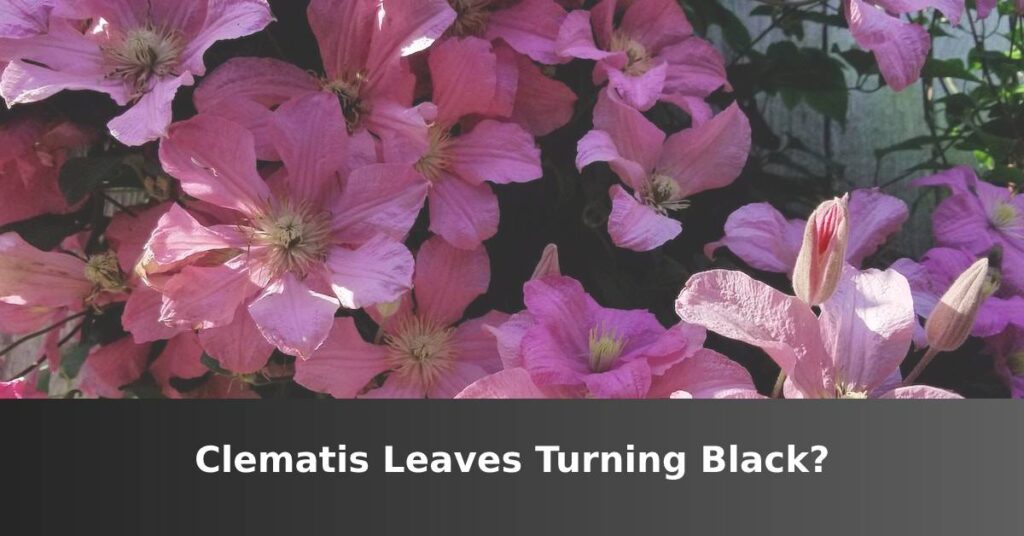As you probably already know, clematis leaves are usually a nice green color when healthy and growing well.
So when a clematis plant begins to develop leaves that turn black, you should be alarmed, as this is a sign that the plant is under some form of stress that it shouldn’t.
Time is running out in this case, so here are the main causes of black leaves on a clematis and what to do about it.
Contents
excess water
Overwatering a clematis can be quite common among gardeners, as this plant needs the soil to stay moist to grow and look its best.
By trying to keep the soil moist, you risk overwatering the plant or the soil may not drain properly, allowing standing water to damage the roots.
I would say that overwatering is the most common cause of clematis leaf blackening, as it’s pretty easy to do or miss.
Unfortunately, overwatering plants often leads to root rot, which, if not treated quickly, can lead to the death of a plant.
Some signs that you may be overwatering your clematis are droopy leaves, yellowing of the leaves, browning of the leaves before they turn black, and foul smelling roots.
Usually, however, you will notice the leaves dropping or yellowing first before they begin to turn brown or black.
This means that if the cause is too much water, you need to correct it quickly.
Solution
When watering a clematis, one of the most important things to know is knowing when to water.
The best way to find out is to check the floor beforehand each time.
You want the top inch of soil to be completely dry before watering the plant, as this will help prevent overwatering but will keep the soil moist at the bottom.
Since you’ve probably already overwatered, check the roots for rotting.
First, be sure to wear protective gardening gloves before handling a clematis.
If the roots are white and firm, you don’t have root rot, but if the roots are black, mushy, or smell strange, then your plant has root rot.
From there, you will want to prune the affected leaves and roots with sterile garden shears.
Then, transplant your clematis into fresh soil and rest in water for a few days.
This will give your plant the best chance of surviving and getting back on track.
sun damage
While most types of clematis grow quite well in full sun for most of the day, in extreme temperatures, this type of light and therefore heat can cause clematis leaves to get sunburned. .
Typically, when sunburned, your plant may have curly, brown buds before they turn black and drop off.
Extreme heat is also a cause of red leaves on a clematis.
When I say extreme heat, I usually mean temperatures above 80 degrees, which is often mid-summer.
So if you’re reading this right now and you’re noticing the symptoms above, it might be time to find a new location for your plant.
Solution
Although you want your clematis to get plenty of light each day, you also want to protect it from the summer sun.
So if you expect temperatures to be above normal, find a shaded spot for at least a few hours a day.
This can be done by growing crops under certain trees, under a balcony, or using some of them. Good quality shade cloth when you need it most.
If you are actually growing indoors, the plant may be too close to the light source, for example, right against the windows.
It’s best grown a few feet away from a particular window to avoid amplifying the sun’s rays and hitting the foliage more than it should.
Unfortunately, sunburned leaves need to be pruned, as they will not return to normal on their own.
That being said, pruning severely damaged leaves will make it much easier for plants to produce new growth.
pests and sooty mold
Sometimes you may encounter pests when growing clematis, such as mealybugs, scale insects, thrips or aphids.
These pests are known to feed on plant sap, causing loss of nutrients and general dehydration of the host.
They also leave behind a honeydew substance, which eventually turns into sooty mold which may be the cause of black leaves.
Sooty mold is a fungal problem that can appear dark black or brown, usually on the tops of leaves when they form from honeydew left behind.
Sooty mold is actually quite harmless and won’t affect the health of your Clematis plant, but it can be quite unsightly and unsightly.
Pests, on the other hand, can cause all kinds of damage to your plant, including curled, droopy or withered leaves, holes in the foliage, yellowing or paleness, sticky leaves, etc.
Some signs that you might have pests include small white or black dots (often the pests themselves), spots of discoloration, bumps on the tips of leaves, and other symptoms listed above.
Solution
Normally, you can use an alcohol swab to remove individual pests, but this is time-consuming, tedious, and can also fight mold.
So in this case, I would recommend using neem oil as it also works great for pest control and eliminating fungus.
If you are looking for neem oil spray, you can get it here.
Just be sure to spray the entire clematis, including the undersides of the leaves and the soil, to make sure the pests have nowhere to stay.
Also, only spray in the shade until the neem has a chance to dry out.
final thoughts
I am very sure that one of these causes is to blame for the formation of black leaves on your Clematis plant.
All in all, I hope you found this informative and helpful so you can fix this problem and grow a happy, healthy plant again.
Good gardening as always and good experience!
